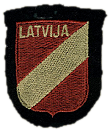2
useful to review the factual contentions which give rise to this proceeding. The government charges that Vilis Hazners persecuted Jews at the police Prefecture at Riga, Latvia in July 1941, and at the Riga ghetto in September, October and November of the same year; he was therefore ineligible for the visa he received under the Refugee Relief Act and inadmissible to the United States. 1/
We do not accuse the respondent of membership in the Latvian secret police, known as the Arajs command, and we do not charge that the respondent's service with the 15th Waffen-Grenadier Division of the SS was undistinguished 1(though concealing SS service probably rendered him ineligible to enter the United States.) 2/
The sole question in this proceeding is whether Vilis Hazners persecuted or assisted in the persecution of any person or group of people in Riga during the last six months of 1941. 3/ The government has alleged that he did so on several occasions during the first days and months of the German occupation of Latvia.
| 1/ | The applicable laws are discussed in the following section. |
| 2/ | 2"From this alone [a Waffen-SS Commission] an inference of war criminality is warranted unless other facts demonstrate the contrary." Soobzokov v. Blum, No. 77-1750, slip op. at 4 (S.D.N.Y. February 28, 1978) |
| 3/ | Persecution is defined in Webster's Third New International Dictionary as "The act or practice of persecuting: as (1): the infliction of sufferings, harm, or death on those who differ (as in origin religion or social outlook) in a way regarded as offensive or meriting extirpation. (2) a campaign having for its object the subjugation or extirpation of the adherents of a religion or way of life ..." Op.cit., 1685 (1971). |
Examination
The INS's contention that Hāzners concealed his Waffen-SS service in order to enter the United States is patently false.
The INS introduces its systemic bias, that being commissioned as an officer in the Waffen-SS equals guilty as a war criminal unless proven otherwise, citing a defamation case involving someone accused of being a Holocaust perpetrator (Soobzokov) versus a "Nazis among us" exposé author (Blum). The questions are:
- Who is contending the inference?
- What are the circumstances surrounding the inference?
- Why cite a defamation case in which the INS, as it turns out, is not an objective observer?
Examining what Blum wrote about Soobzokov in "Wanted! The Search for Nazis in America" (pp.30-31):
Harold Goldberg [self-styled Nazi hunter] had read this news report [Soobzokov awarded citation "for the outstanding job he had done in aiding displaced persons forced out of their native country to find a new life and democracy in America"] hundreds of times in the last three years, but still he never failed to be infuriated by its horrible irony. This model immigrant success story was based on lies, fears, and threats. He knew the truth: This "distinguished servant of all mankind" had served as an Obersturmfuehrer in the Waffen-SS, the equivalent of a first lieutenant in a Nazi mobile killing unit that had participated in the murder of 1,400,000 Jews on the Eastern Front.
The non-German Waffen-SS served as combat units on the Eastern Front, operationally under the Wehrmacht—it was the Einsatzgruppen and their collaborative units who comprised Hitler's death squads. While we are not familiar with Soobzokov's case, we would observe it seems poor form for the INS to cite a defamation case in which they themselves had an interest. At the time of this brief, the INS had already been pursuing Soobzokov for 8 years. The successor OSI terminated its investigation three years later, in 1982. Soobzokov's state and federal defamation suits against Blum et al. were subsequently settled by sealed court order in 1983.
One might have hoped that when it comes to proving someone is a war criminal, the INS would hold itself to a higher standard than inferences of guilt. Or, perhaps the INS was attempting to "lower the bar" as far as possible.
